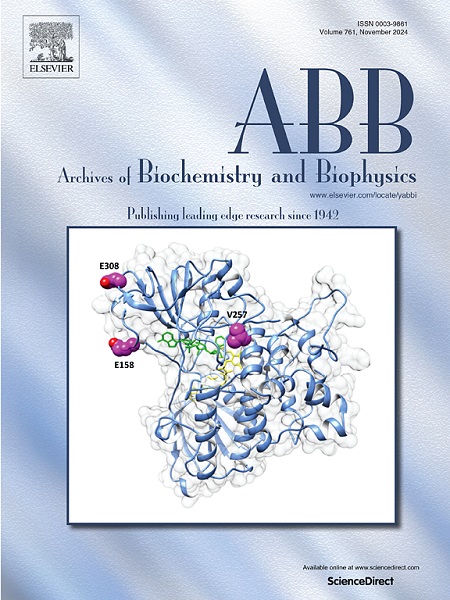1h -苯并咪唑-2-酰基腙的新型金属配合物:细胞抑制、促凋亡和激酶信号通路的调节活性。
IF 3.8
3区 生物学
Q2 BIOCHEMISTRY & MOLECULAR BIOLOGY
引用次数: 0
摘要
用氯化铜络合得到了两个h -苯并咪唑-2-酰基腙的铜配合物。通过微化学分析、SEM-EDX、红外光谱、微拉曼光谱和DFT计算研究了配合物的分子结构。结果表明,两种配体均与铜形成1:1的配合物,铜离子分别由苯并咪唑环上的n原子、亚甲基键上的n原子、芳环上的正- oh基团上的o原子和一个氯原子配位。配位过程显著影响了它们的细胞毒性。2-(2-羟基苄基)-1-(1h -苯并咪唑-2-基)肼的转化。变成Cu络合物2.1。导致其对AR-230细胞的抗白血病活性增加2.4倍,对MCF-7乳腺癌细胞系的细胞抑制活性增加8倍。2-(2-羟基-4-甲氧基苄基)-1-(1h -苯并咪唑-2-基)联氨Cu配合物的生长抑制作用对MCF-7细胞的作用与相应配体的作用相当,但对白血病AR-230细胞群缺乏作用。关于它们对CCL-1细胞的细胞毒性潜力,两种铜配合物都表现出较弱的选择性模式,与其配体相比。1.1和2.1的促凋亡和调节活性。在ER+乳腺癌(MCF-7)和bcr-abl+白血病(AR-230)体外肿瘤模型中进一步研究关键激酶信号通路的影响,并分别与参比药物他莫昔芬和伊马替尼进行比较。JAK/STAT信号通路的抑制被认为是体外抗Ph+ AR-230模型抗白血病活性的重要机制,而外源性凋亡通路的募集和激活在MCF-7细胞中被建立。本文章由计算机程序翻译,如有差异,请以英文原文为准。

New metal complexes of 1H-benzimidazole-2-yl hydrazones: Cytostatic, proapoptotic and modulatory activity on kinase signaling pathways
The copper complexes of two 1H-benzimidazole-2-yl hydrazones were obtained by complexation with copper chloride. The molecular structure of the complexes was studied by microchemical analysis, SEM-EDX, IR and micro-Raman spectroscopy and DFT calculations. It was found that both ligands form 1:1 complexes with the copper, where the Cu ions are coordinated by N-atom from the benzimidazole ring, N-atom of the azomethine bond, O-atom from the ortho-OH group of the aromatic ring and one chlorine atom. The coordination process significantly affected their cytotoxicity profile. The conversion of 2-(2-hydroxybenzylidene)-1-(1H-benzimidazol-2-yl)hydrazine 1.1. into a Cu complex 2.1. led to a 2.4-fold increase in its antileukemic activity against AR-230 cells and an 8-fold increase in the cytostatic activity against MCF-7 breast cancer cell line. The growth-inhibitory effect of the Cu complex of 2-(2-hydroxy-4-methoxybenzylidene)-1-(1H-benzimidazol-2-yl)hydrazine 2.2. on the MCF-7 cells was comparable to that of the respective ligand, however lacked towards the leukemic AR-230 cell population. Regarding their cytotoxic potential towards CCL-1 cells, both Cu complexes exhibited a weaker selectivity pattern as compared to their ligands. The proapoptotic and modulatory activity of 1.1 and 2.1. on key kinase signaling pathways was further studied in the ER + breast cancer (MCF-7) and bcr-abl + leukemic (AR-230) in vitro tumor models in a comparative manner to the reference drugs tamoxifen and imatinib, respectively. Inhibition of the JAK/STAT signaling pathway was outlined as a prominent mechanism in the antileukemic activity against the Ph + AR-230 in vitro model, whereas recruitment and activation of the extrinsic apoptotic pathway was established in the MCF-7 cells.
求助全文
通过发布文献求助,成功后即可免费获取论文全文。
去求助
来源期刊

Archives of biochemistry and biophysics
生物-生化与分子生物学
CiteScore
7.40
自引率
0.00%
发文量
245
审稿时长
26 days
期刊介绍:
Archives of Biochemistry and Biophysics publishes quality original articles and reviews in the developing areas of biochemistry and biophysics.
Research Areas Include:
• Enzyme and protein structure, function, regulation. Folding, turnover, and post-translational processing
• Biological oxidations, free radical reactions, redox signaling, oxygenases, P450 reactions
• Signal transduction, receptors, membrane transport, intracellular signals. Cellular and integrated metabolism.
 求助内容:
求助内容: 应助结果提醒方式:
应助结果提醒方式:


